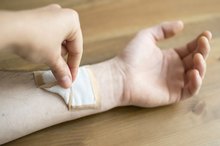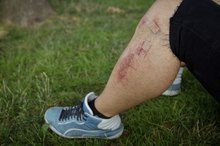How to Use Aquacel
Aquacel is a sterile dressing used to cover acute and chronic wounds that are excreting pus or other fluids. The dressing is used on ulcers, graft sites and lesions that would benefit from staying moist. The active ingredient in the Aquacel dressing is sodium carboxymethylcellulose. Aquacel draws excess moisture away from a wound and traps the bacteria. Excess moisture is retained in the dressing to keep the wound from drying out, which promotes wound healing.
Wash your hands with soap and water.
How to Use Promogran Prisma Matrix Wound Dressing
Learn More
Apply a topical antibiotic medication to the wound if prescribed by your doctor.
Pour isopropyl alcohol onto scissors to sterilize the cutting surface. Let the scissors air dry.
How to Remove Gauze That Sticks to Wounds
Learn More
Cut Aquacel dressing with sterile scissors to a size that is a little larger than the wound.
Lay the Aquacel dressing directly on top of the wound.
Moisten Aquacel dressing with saline water solution if the wound is very dry. If the wound is excreting pus or other fluids, the dressing does not need to be moistened.
Cover the Aquacel dressing with a second sterile dressing 1. Use gauze if the wound is very wet, to absorb excess moisture. Use a plastic backed dressing if the wound is only a little wet, to help hold moisture in the Aquacel dressing. Fix the secondary dressing over the Aquacel dressing with surgical tape.
Change the Aquacel dressing once a day if the wound is excreting a lot of fluid. The dressing can be left on for up to seven days for dryer wounds. If the Aquacel dressing sticks to the wound, apply saline water solution to loosen the dressing. Check with your doctor for a recommended dressing change schedule.
Warnings
Do not use Aquacel if you are sensitive or allergic to sodium carboxymethylcellulose.
Related Articles
References
Warnings
- Do not use Aquacel if you are sensitive or allergic to sodium carboxymethylcellulose.
Writer Bio
Rose Kivi has been a writer for more than 10 years. She has a background in the nursing field, wildlife rehabilitation and habitat conservation. Kivi has authored educational textbooks, patient health care pamphlets, animal husbandry guides, outdoor survival manuals and was a contributing writer for two books in the Uncle John’s Bathroom Reader Series.







